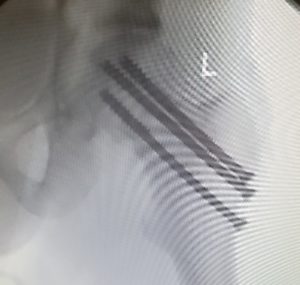Femoral neck fractures, when displaced in physiologically young people, are best treated with anatomic reduction and screw fixation promptly. Elderly patients are better treated with replacement of the femoral head. My results are better with open reduction through the Smith Peterson approach going medial to rectus femoris. With open reduction, the hemarthrosis can be decompressed well, fracture reduction can be improved, and femoral head vascularity evaluated by drilling a small hole in the head looking for active bleeding.
Technique – Manipulate the head with a joystick, traction, and internal rotation of the neck. Try to get anatomic or slight valgus reduction. A clamp can be used to compress the fracture site. Internal fixation with 2-3 screws is good. DHS was shown to be stronger, but has higher AVN rate. In adults, 3 screws are standard for fixation. Dr. Prasad Gourineni uses two short threaded screws to lag the head into slight valgus and place a fully threaded screw along the calcar to prevent shortening. All screws start laterally above the level of the lesser trochanter and placed juxta cortical in the neck and advanced close to the subchondral bone. In older children the physis can be ignored and crossed with the screws and in younger children, the screws can end short of the physis and the guide wires can be left in the head to protect the epiphysis from slipping.
Biplane Double Support fixation (BDSF) with screws was supported by two large series in older patients.

Left femoral neck fracture treated with valgus reduction and parallel screw fixation.
